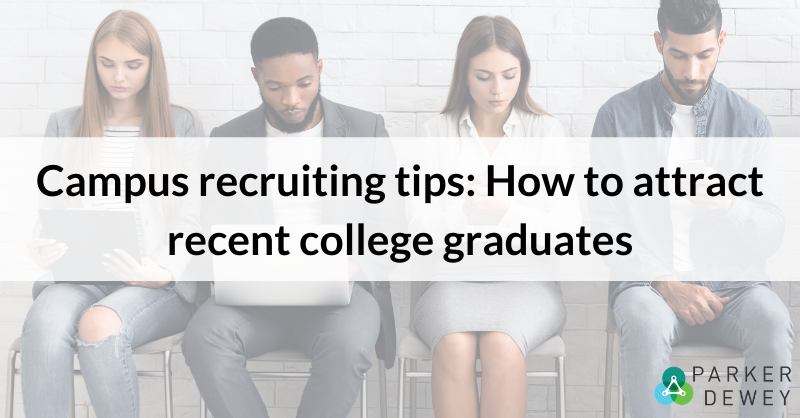.png)
On Engaging Top Talent This Fall
How well do you think companies and schools responded to virtual recruiting last year?
What were some of the realized and potential opportunities for recruiters from the shift to virtual?
What do students and recent graduates want right now after a year+ of disruption?
These were among the topics covered during last week’s The State of Campus Recruiting webinar, where I was joined by Lindsey Pollak (NYT bestselling author and workplace and career expert) and David Ong (Senior Director of Talent Acquisition at MAXIMUS and President-Elect of NACE).
During this session, Lindsey and David shared some invaluable insights for the coming year around early access, driving diversity, and ensuring success in what will be another unusual year. In particular, both of these experts highlighted the importance of finding creative, personalized ways for companies to engage prospective candidates that get through the noise and build real relationships.
See one of the key takeaways from the conversation below. You can also read more about their learnings and suggestions in a summary of the session, or see the webinar replay.
Jeffrey Moss, Founder and CEO
The shift to remote forced companies and schools to ask: how do we find creative, personalized ways to engage with talent?
Last year, our Fall Recruiting Student Sentiment Survey found that more than 86% of students rated "real work experience" as their preferred method of engagement with employers, allowing them to learn about potential roles they may not have otherwise considered. And with just over half of students last year expecting virtual career fairs to be an effective way to engage them, talent acquisition teams needed to look beyond virtual versions of traditional tactics to ensure successful engagement, diversity, and conversion outcomes.
David: The best piece of advice we got from schools where we recruited was pretty simple: "Just because it works in a live environment, don’t assume it’ll work in a Zoom environment."
Lindsey: A lot of students who went through internship programs [last year] said their favorite thing was access to senior leaders in small groups. So maybe the CEO would have done a town hall that you got to participate in but virtually, it was much easier for executives around the world to do five people on a Zoom—so they really felt that one-on-one access was critical and the number one thing they wanted to keep from an intern perspective.
For more insights, see the summary or webinar replay.
Articles of the Week
Should candidates be paid to do a job interview? - LinkedIn Talent Blog
From Cultural Fit to Cultural Fitness - ERE
You Asked, They Answered: How you spent your pandemic - Parker Dewey
Should candidates be paid to do a job interview? - LinkedIn Talent Blog
"’We need more transparency and for hiring to be aligned to a company’s business case. If paying is the catalyst, then so be it.’”
While this article focuses on interviewing experienced professionals, the points are even more important when recruiting college students and recent graduates. Many of these career launchers rely on part-time work to pay for college and other expenses, and therefore traditional campus recruiting processes artificially filter them out, hurting both students and companies - in fact, this is a big reason why unpaid internships are widely criticized. While we can see both sides of the argument for paid interviews, we do feel strongly that tools like Micro-Internships can overcome this issue in a way that benefits both companies and candidates. This is why Parker Dewey’s Micro-Internships are always compensated, empowering candidates to “audition” for a job while getting paid and ensuring companies have access to top candidates.
Related reading: Here’s Why Micro-Internships are Always Paid
From Cultural Fit to Cultural Fitness - ERE
“Companies should replace cultural fit with cultural fitness in the selection of candidates. The latter suggest that differences can be a source of inspiration and renewal, rather than a potential bottleneck leading to frustration. Meanwhile, anyone who is into fitness knows that it is about giving and getting energy.”
The idea of culture fit may seem like a no-brainer—why not hire candidates that resemble existing employees? But in actuality, culture fit promotes homogeneity within an organization, undermines diversity and inclusion, and reduces your candidate pool to a fault. Instead of “fit,” it’s time to focus on “culture fitness,” or the notion that “differences can be a source of inspiration and renewal.” This article explains why.
Related reading: Diversity Recruiting
You Asked, They Answered: How you spent your pandemic - Parker Dewey
Each month, we ask our network of career launchers (open to 11+ million degree-earners!) for their burning questions about getting hired, what recruiters are looking for, and general advice from hiring managers and recruiters. In last month’s post, our experts weighed in on how career launchers might respond to a question like “What have you been doing over this past year in terms of your professional development?” If you’re an early-career professional interested in contributing to future “You Asked, They Answered” posts, check out the link below
Related reading: Join our expert network
For more stories and insights on HR, recruiting, and diversity, click here to subscribe to our weekly newsletter Hire Learnings.


.png?width=800&name=Webinar%20graphics%20(1).png)

.png)
